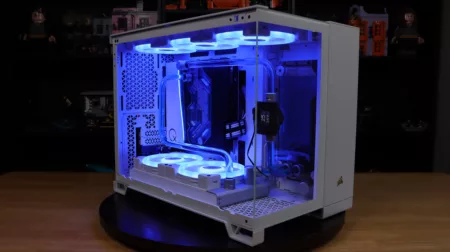Today we’ll be looking at a video card from Palit, one of their high-end model entries in their Jetstream series, a custom-cooled Geforce GTX670 brandishing factory overclocked frequencies, a custom designed PCB and a sexy-looking cooler. Let’s see if this card is more than just flash and customizations, let’s make this review showy!
Palit’s Jetstream line has currently a pair of entries in its line-up, one is the flagship Geforce GTX680 and the other is what we have for review today: the Geforce GTX670. The latter being a castrated version of the GTX680 with a couple of shader processors disabled as well as having a reduced PCB. Based on the GK104 GPU, the GTX670 has a 1344 CUDA cores with 112 texture and 32 raster operating units which are very impressive specs making this quite the powerful graphics card with a base clock of 915Mhz and a Boost Clock of 980Mhz. Palit’s factory overclocked Jetstream comes with a 1006Mhz baseclock and an impressive 1084Mhz Boost frequency which is aided by a 2048MB framebuffer on a 256-bit bus clocked in a 6108Mhz. Contrary to its previous generation processor, the Jetstream has a TDP of 180watts that’s a bit higher than reference but is a pretty respectable power draw for a card of this status.
About Palit
Established in 1988, Palit Microsystems Ltd. is well-known for manufacturing stable, excellent, and innovative electronics products. As one of the top PC components manufacturers, Palit continues to provide top-to-bottom graphics cards and USB Flash Drive with stable and excellent quality to the world. With main operation in Taipei, logistic center in Hong Kong, factories in Mainland China, and branch office in Germany, Palit has developed a worldwide sales network and cooperated closely with our customers.
Palit is well positioned to maintain an industry leadership due to the vast array of ATi and NVIDIA products and on-going development efforts. Palit’s worldwide facilities are ISO 9001 certified. All the Palit PC graphics accelerators and motherboards are with WHQL certification to ensure full compatibility.
| Memory Amount | 2048MB |
| Memory Interface | 256bit |
| DRAM Type | GDDR5 |
| Graphics Clock (MHz) | Base Clock 1006MHz/Boost Clock 1084MHz |
| Memory Clock (MHz) | 3054MHz (DDR 6108MHz) |
| CUDA Cores | 1344 |
| Memory Bandwidth (GB/sec) | 195.5 |
| NVIDIA SLI-ready | 2-way |
| NVIDIA 3D Vision Ready | ✔ |
| NVIDIA 3D Vision Surround Ready | ✔ |
| NVIDIA PureVideo HD Technology | ✔ |
| NVIDIA PhysX-ready | ✔ |
| NVIDIA CUDA Technology | ✔ |
| NVIDIA FXAA Technology | ✔ |
| Blu-ray 3D Support | ✔ |
| TrueHD and DTS-HD Audio Bitstreaming Support | ✔ |
| Microsoft DirectX | 11 |
| OpenGL | 4.2 |
| Bus Support | PCIE 3.0 |
| Certified for Windows 7 | ✔ |
| Maximum Digital Resolution | 2560×1600 |
| Maximum VGA Resolution | 2048×1536 |
| Dual-Link DVI | Yes x2 |
| HDCP | ✔ |
| HDMI | 1.4a |
| DisplayPort | ✔ |
| Height | 2.5 Slot |
| PCB Width | 247mm x 112mm |
| Graphics Card Power (W) | 185 W |
| Minimum Recommended System Power (W) | 500 W |
| Supplementary Power Connectors | 6-pin X2 |
| Accessory | Manual, CD Driver, Power Cable, HDMI-DVI Adapter, DVI-CRT Adapter |
Aside from those tech specs ripped from Palit, nVidia’s new Kepler architecture features some new technology that aims to benefit gamers. First up is GPU Boost which is basically the same as Intel’s Turbo Boost technology which in simple terms increases the clocks of the GPU depending on the workload. Also worth noting is that GPU Boost works on top of your overclocked frequency as long as it is within TDP.
Also new to the table is nVidia 3D Vision Surround technology which enables a single graphics card to drive up to 3 display in full 3D, but if you don’t have 3D capabilities it’ll still support multiple monitors, up to 4, the 3 acting as surround display and the fourth as an accessory display.
Both nVidia and AMD’s latest card offering are all PCI Express Gen 3 ready. This new specification doubles the bandwidth of PCI-e Gen 2 and provides more data transfer speeds for newer games and applications. All PCI-e Gen 3 devices are backwards compatible so there’s no problem with compatibility.
Last up is Adaptive VSync, which helps improve visual quality by providing a smoother experience. Adaptive Vsync technology adjusts VSync settings so screen tearing and stuttering is reduced by dynamically switching VSync on or off.
IMAGE GALLERY
Palit packages their Jetstream GTX670 in a large box with an Asian motif going on. The character reads as “kaze” in Japanese and translates to wind in support of their Jetstream theme.
The front of the box is a flap that opens up to reveal a window where we can see the Jetstream GTX670 and its lovely cooler. This version features two fans whereas the Jetstream GTX680 has three. The back of the flap notes some features and highlights of the GTX670. Â The back of the box lays down more marketing highlights and includes shots of a couple of games.
The box also features a handle for easy carrying. Standard on most high-end boxes, if there was such a thing as a high-end box. So moving on to the content of the package we have the Jetstream GTX670 from Palit and includes a driver installation CD, output converter plugs (HDMI-to-DVI and DVI-to-VGA), an installation guide and a dual-MOLEX to 6-pin converter which we don’t recommend you use. Come on, if you’re going for a card like this you’d have a nice power supply already.
And here are a couple of shots of our Jetstream GTX670 from different angles for your consideration.
As with most manufacturers trying to stick with the normal placement of the 6-pin power connector ports are on the edge of the board but since some of these companies try to extend their cards by using over-extended coolers, the ports end up slightly off-center which would not fare nicely with some people especially those who prefer tight cable management.
PERFORMANCE
Test Setup
| Processor | Intel Ivy Bridge i7-3770K 3.5Ghz (Turbo up to 3.9Ghz) |
| Motherboards | ECS Z77H2-A2X Golden Board |
| Cooling | Corsair H80 |
| Power Supply | Silverstone Strider Plus ST65F-P 650W |
| Memory | Kingston HyperX Genesis Quad-Channel DDR3-1600 |
| Video Cards | Palit Jetstream GTX670, Sapphire HD6850, PowerColor HD7770 PCS+ |
| Hard Drive | Kingston HyperX SSD 120GB, Western Digital VelociRaptor 1TB |
| Operating System | Windows 7 64-bit SP1 |
We would like to thank ECS, Palit, and Kingston Technologies Inc. for providing the parts and equipment for this review.
Overclocking
Using MSI’s Afterburner utility, we managed to bump our cards with 50mhz more juice on the core and memory clock. I feel that we would go further but reaching 82*C, we felt our 50mhz bump to be sufficient as thanks to the GPU boost, we’re reaching frequencies up to 1200Mhz+ frequencies.
Moving on to our tests, this is not intended to be a show-down between the test cards and we include the Radeons for reference only. We will be updating the graphs here with comparatives from other cards. We’ll keep you posted when we refresh our graphs.
Capcom’s Resident Evil spin-off title Operation: Racoon City puts us in the boots of Umbrella’s Delta Team comprising of their top operatives who get caught into the company’s twisted scheme in covering up their insidious activities.
STALKER: Call of Pripyat is an FPS title from GSC Game World. The game was released in 2010 but being a DirectX11, is still relevant in most applications. The game features a benchmarking tool to assess the user’s system, doing a 4-scenario test to fully simulate every in-game environment.
Another MMO installation in the storied Final Fantasy franchise, Final Fantasy XIV isn’t really the most hotly anticipated game but we’ll include it here since it has a nice benchmarking tool.
Sniper Elite V2 is a remake of the acclaimed original game from 2009 which puts the player in the shoes of a World War 2 sniper in the heart of Germany. With an updated game engine, the visuals are heavily improved. The game has a benchmark tool to assess how the game will perform on a preset scenario.
Resident Evil 5 sends players to uncharted regions as famed S.T.A.R.S. agent Chris Redfield.
Devil May Cry 4 show’s how Capcom still has love for PC gamers. Follow Nero and Dante as they hack, shoot and slash their way through countless enemies in style in this awesome fast-paced action game.
Battlefield 3 is one of the hottest titles of 2011 and continues to prove itself a worthy game. Based on DICE’s Frostbite Engine 2, this game’s lush details and visuals are just stunning but can really stress any modern GPU.
Unigine Heaven 3.0 is the latest iteration of the benchmarking utility for the Unigine engine. This benchmark stresses any GPU with options for DX9 to DX11 tests and boasts highly impressive tessellation scenes.
Temperature & Power Consumption
To measure both power consumption and heat, we stress the video card and record the peak values for heat and wattage. Our test system consumes an average of of 254W when the GPU is on full-load. Subtracting the idle wattage from this figure gives us 168watts which should be more or less give us a good idea of how much power the card consumes while working. These are measurements taken from the wall socket so its the wattage being drawn by the entire PC. Take note that these also peak values and not the average that these cards will consume. To compute how much power is being drawn by the card, we subtract the idle temps from peak temps and some 10 watts and we get a rough idea of how much power the card draws. Compared to our other cards it might look monstrous it is justified and compared to previous generations, it is a nice improvement in terms of efficiency.
As we can see in the graph, the Palit Jetstream GTX670 sits nicely below 80*C which is good to know considering the fact that our ambient room temps were in the 30-32*C range. Palit’s custom cooling solution manages to cool our graphics card to nice levels even compared to a less-performing HD6850. The fans are also barely audible even when at full-load. Note that these fans are on automatic settings and during our monitoring, the fans remain at 60-70% speed/2100RPM even at full-load so there might be some possibility for the card to be cooler but at the expense of noise levels.
CONCLUSION
Palit definitely has everything going right here with their Jetstream GTX670. First we have a nicely made cooler that’s just awesome to look at. Although big, those who have nicely spaced PCI-e slots will have no problems fitting two of these in their rigs. The cooler itself works nicely taming our cards’ temps and does so quietly. Performance is really well up-there and we’ll update these graphs once we get our hands on the GTX680 for a better look but right now this card is a contender to the vanilla GTX680 in terms of frequencies. We managed to get an average of 67FPS on BF3, Ultra settings and everything, so I guess that should please a lot of gamers especially those who prefer the 1920×1080 setup.
We can’t really think of anything bad to say about the Jetstream. Little details like how the two 6-pin power connectors are on an awkward spot does little to change our views of the Jetstream GTX670. So it all boils down to price and coming in locally at Php18,000, it is easily the cheapest factory-OC’ed GTX670 out there right now. Add to that the custom PCB and cooling and its definitely well worth it along with the performance you’ll be getting.
Definitely a recommended product if you want a tricked-out GTX670 with a bit of OC headroom.





